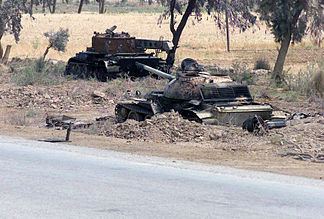Dates 31 Mar 2003 – 6 Apr 2003 | Result American victory | |
 | ||
170–260 killed 13–21 killed1 M1 Abrams tank disabled1 M2A2 Bradley destroyed1 US Navy FA-18 shot down1 UH-60 Black Hawk shot down Similar Battle of Samawah, Operation Augurs of Prosperity, Battle of Umm Qasr | ||
Polish battle of karbala 2004 iraq
The Battle of Karbala took place during the 2003 invasion of Iraq as American troops fought to clear the city of Iraqi forces. The city had been bypassed during the advance on Baghdad, leaving American units to clear it in two days of street fighting against Iraqi irregular forces.
Contents
On 29 March, a suicide bomber (identified as Ali Jaafar al-Noamani, a noncommissioned officer), killed 4 US servicemen (Sergeant Eugene Williams, Corporal Michael Curtin and Privates 1st Class Michael Weldon and Diego Rincon), on Highway 9 on the outskirts of Karbala.
Bypassing the city
Lead elements of the U.S. 3rd Infantry Division had reached the Karbala area on 31 March. After fighting through Republican Guard forces southeast of the city, these forces bypassed the city and attacked through the Karbala Gap towards Baghdad. The task of clearing the city was left to the 101st Airborne Division, supported by the 2nd Battalion, 70th Armor Regiment with Charlie Company, 1st Battalion, 41st Infantry Regiment, 1st Armored Division. On 2 April, a U.S. Army UH-60 Blackhawk helicopter was shot down by small arms fire near Karbala, killing 7 soldiers. Four other soldiers on board were wounded.
Capturing Karbala
The 101st planned to use helicopter-borne forces to seize three landing zones on the outskirts of the city (codenamed Sparrow, Finch and Robin) and then use an armored force of M1 Abrams tanks and M2 Bradley fighting vehicles to link up with these forces.
At 11:00 a.m. on 5 April, the 101st Airborne began its push to clear Karbala when airstrikes hit several targets around the city. This was followed by a helicopter assault in which 23 UH-60 Blackhawk and 5 CH-47 Chinook helicopters ferried three battalions of infantry from the 502nd Infantry Regiment to their designated landing zones.
3rd Battalion, 502nd Infantry at LZ Sparrow met heavy but disorganized resistance as they moved into the city. To the south, 2/502 at LZ Robin was also moving street by street, and discovered several arms caches hidden in schools. They also discovered a suspected insurgent training camp. By nightfall, 2/502 had cleared 13 of their 30 assigned sectors. 1/502, advancing from LZ Finch in the southeast, captured several weapons caches. Air support from helicopter gunships was used heavily during this operation, and artillery support was also used. Over 100 smoke shells were fired from supporting artillery to screen infantry moving through Karbala's streets. At the same time, 2/70 Armored Regiment and C Co 1/41 IN (Mechanized) had reached Karbala and were engaged in combat, losing 1 man killed from small arms fire and a Bradley to an RPG hit.
The next day, the units continued to clear their sectors. Resistance evaporated by 5:00 PM on 6 April. At 5:30, a large statue of Saddam Hussein was torn down by members of the 2/70, 1st Armored Division.
For their actions in Karbala, 3rd Battalion, 502nd Infantry, 101st Airborne Division was awarded the Valorous Unit Award.
